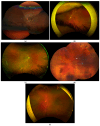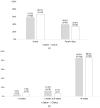A Comparison of Ultra-Widefield Imaging Quality Obtained with Zeiss Clarus and Optos for Virtual Medical Retina Services
- PMID: 40429266
- PMCID: PMC12111814
- DOI: 10.3390/jcm14103270
A Comparison of Ultra-Widefield Imaging Quality Obtained with Zeiss Clarus and Optos for Virtual Medical Retina Services
Abstract
Background: Virtual clinics (VCs) have proven to be an effective solution for the increasing strain on Medical Retina (MR) services, although imaging quality issues (IQIs) persist. Our aim was to compare the quality of two ultra-wide-field (UWF) imaging modalities (Optos and Clarus) in real-world MR-VC settings. Methods: We conducted a real-world, prospective study. Data were collected from 6 Moorfields NHS Trust MR-VCs between September and October 2024. We obtained patient demographics and characteristics, primary diagnosis, UWF imaging types and images obtained, and follow-up outcomes. Results: Optos (California RG/RGB, and Monaco) was used for 56.7% (n = 152) and Zeiss Clarus 500 for 43.3% (n = 116) of the total cohort (n = 268). No statistically significant difference (p = 0.14) was found between the two in terms of the rates of IQIs. FAF (p = 0.001) acquisition was significantly higher when Optos was used. Of the patients affected by IQIs, 10 were examined in a face-to-face clinic (F2FC). No difference in IQI rates was observed when pathology-related poor image quality was considered (p = 0.561). A significantly (p = 0.001) higher rate of F2F follow-ups was found for red-flag pathologies and unexplained vision loss, with a statistically significantly higher rate of virtual follow-ups for non-red-flag pathologies (p = 0.001). Conclusions: A total of 7.5% of the clinical decisions were impacted by IQIs; 11.1% of F2FC follow-ups. Neither UWF imaging modality type was inferior in terms of IQI rates. FAF acquisition was higher with Optos, likely representing greater user-dependency for Clarus. The outcomes were not influenced by FAF acquisition, indicating that routine acquisition is not required in MR-VCs and instead should be obtained when clinically required.
Keywords: Optos; Zeiss Clarus; medical retina virtual clinic; ultrawide-field imaging.
Conflict of interest statement
The authors declare no conflicts of interest.
Figures





References
-
- NHS England Hospital Outpatient Activity 2023-24. [(accessed on 10 December 2024)]. Available online: https://digital.nhs.uk/data-and-information/publications/statistical/hos....
-
- Getting It Right First Time Ophthalmology: GIRFT Programme National Specialty Report. [(accessed on 10 December 2024)]. Available online: https://gettingitrightfirsttime.co.uk/wp-content/uploads/2019/12/Ophthal....
LinkOut - more resources
Full Text Sources

